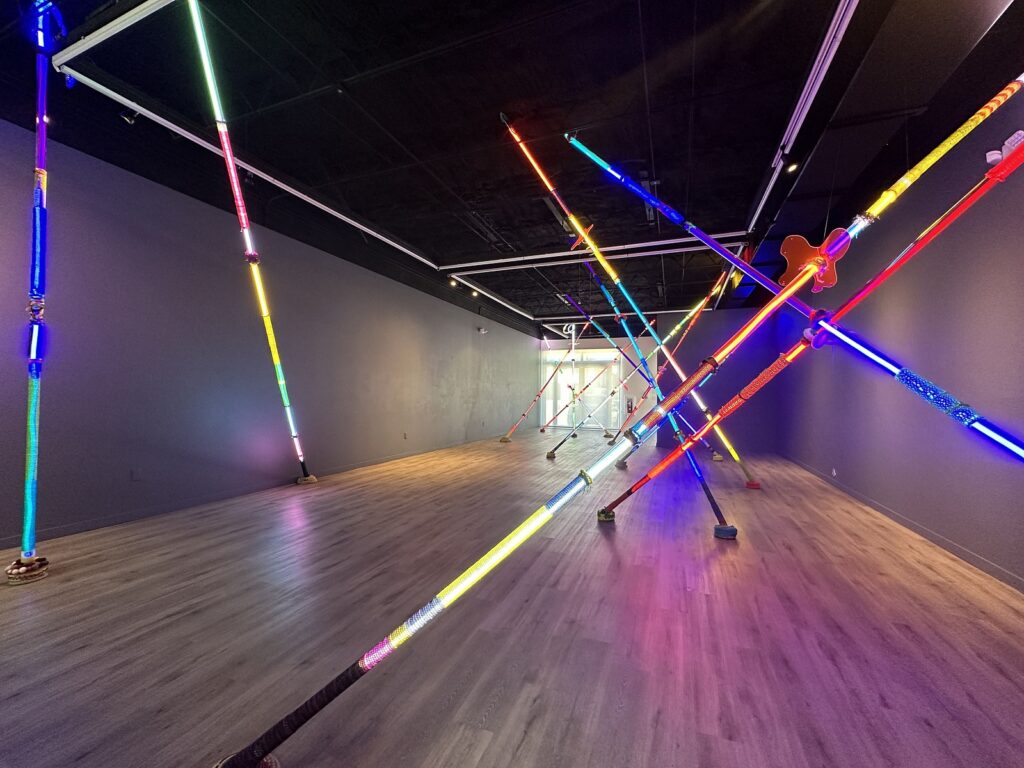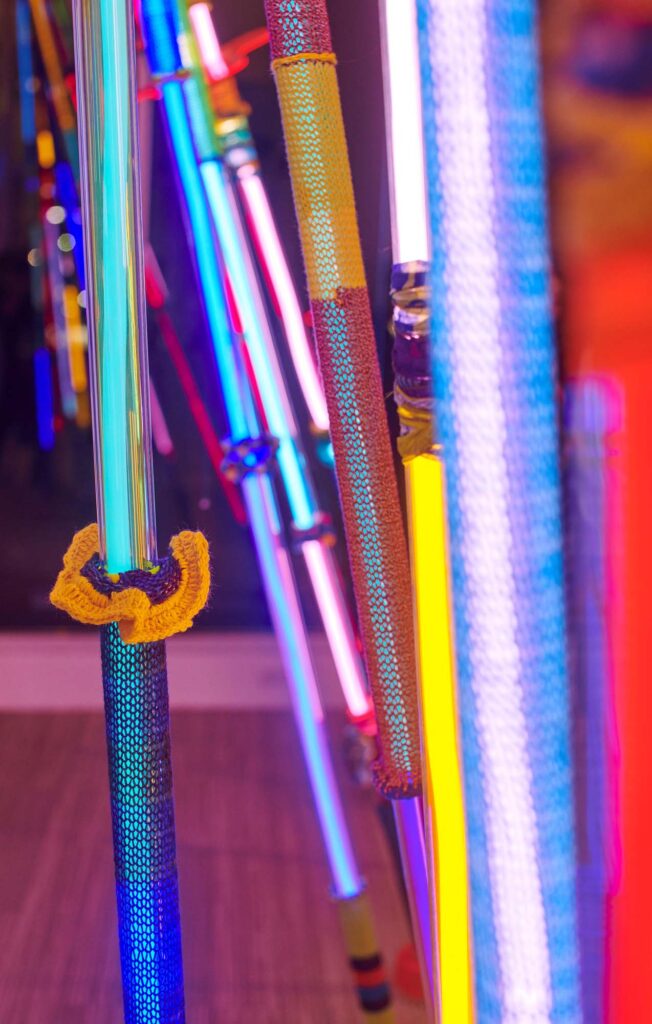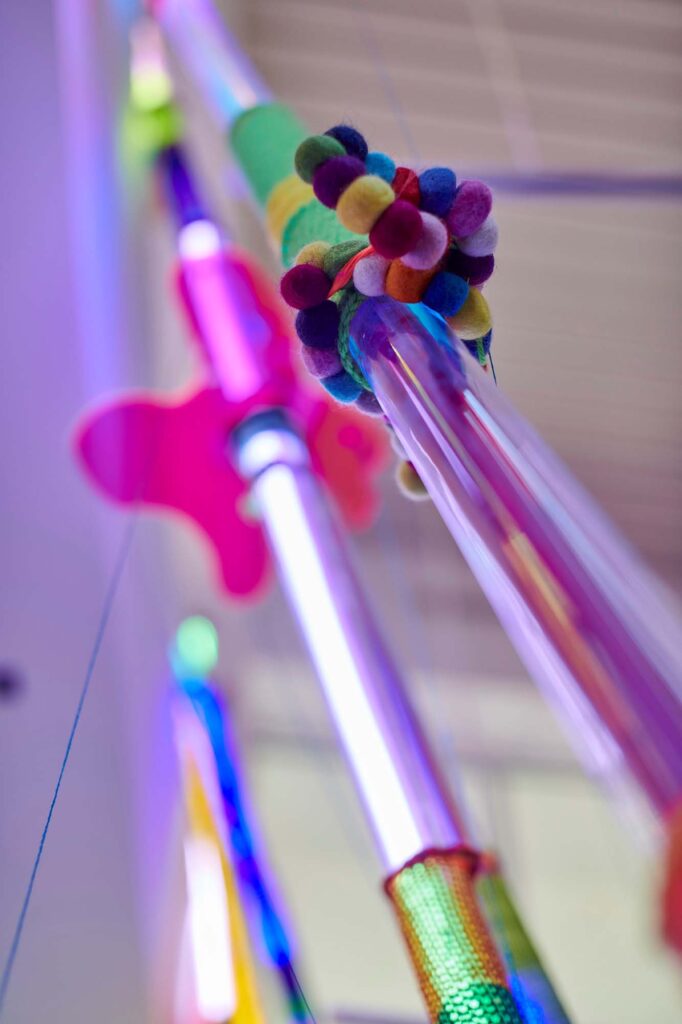
As critic and Art writer Adriana Herrera aptly noted in Art Nexus magazine, “The cultural heterogeneity that emanates from Trimino’s works translates into shapes that resonate for their convergence between personal and collective experience: Trimino interweaves the pathways of various cultures.” This insight underscores the essence of Trimino’s latest
installation.
Glowing from the core and cloaked in handmade textile elements, this installation embodies Alex Trimino’s multimedia methodology. Originally, Trimino viewed knitting, crochet, and weaving through the lens of her Colombian heritage, associating these crafts with traditional domestic roles – which made her initially reluctant to explore them. Yet, by approaching these processes with a geometric fascination, she merged organic materials like yarn and fiber with cutting-edge tech components such as neon lights controlled by microprocessors. She examines the intersectionality of technology, gender, and societal norms. Poised delicately between tradition and innovation, this installation prompts viewers to reflect on how the past informs the present.
Alex Trimino explains her driving force behind this work by stating, “My installations re-contextualize the traditional use of colloquial, lo-tech crafts; crochet, knittings and weavings exploring social views on civilization, technology and gender”. Elaborating on this concept, she adds, “Illuminated totem poles, covered in crochet, knittings and found objects reveal the similarities between the modern, hi-tech materials used (micro-controlled neon lights) and the colloquial, lo-tech crafts used (crochet, knittings and weavings); creating an equilibrium between traditions, technologies and generations. Old ways and new technologies commingle together, exploring how we connect to reality today. I use embroidery and technology, creating a connection between past and present.” By keeping these core ideas at the forefront, Trimino’s work offers a unique perspective on the interplay between tradition and modernity.


Alex Trimino is a Miami-based visual artist born in Colombia. She earned her Master of Fine Arts from Florida International University and attended Ox Bow Artist Residency at the School of the Art Institute of Chicago where she was a recipient of the Joan Mitchell Foundation Scholarship for Visual Artists. Trimino has been recognized with grants and awards from esteemed institutions such as The Patricia & Phillip Frost Art Museum, The Elliot Museum, Appleton Museum of Art, Rawls Museum Arts, Cambridge Art Association, and the Joan Mitchell Foundation. Her work has been extensively exhibited in museums across the United States and internationally, including with solo exhibitions at Läns Museum, Örebro, Sweden and International Art Symposiums. Trimino is represented by Diana Lowenstein Gallery in FL.
Since 1989, Diana Lowenstein has been part of the international art scene through her role as an active gallery owner and director, first under the name Der Brücke and now as the eponymous Diana Lowenstein Gallery.
Mrs. Lowenstein began her career as a gallerist in Argentina, fomenting young local artists as well as organizing exhibitions of world-renowned foreign artists.
Participating in high-caliber art fairs like FIAC in Paris, ARCO in Madrid, Art Basel, Art Chicago and Art Miami has been a staple in the gallery’s operation. Furthermore, Diana Lowenstein has been part of numerous organizing committees of these fairs, being able to influence their orientation to include a quality Latin American mix of talent.
In September of 2000, the gallery headquarters were moved to Miami. It is now based in Magic City District, the gallery has thirty-two years of specialized experience presenting contemporary art in the United States and across the globe. The Diana Lowenstein Gallery runs a year-long exhibition program in Miami and participates in the world’s most exclusive art fairs, presenting the works of its stable of international artists. She has made it possible for many of her exclusive artists to exhibit works in major world museums and biennales.

